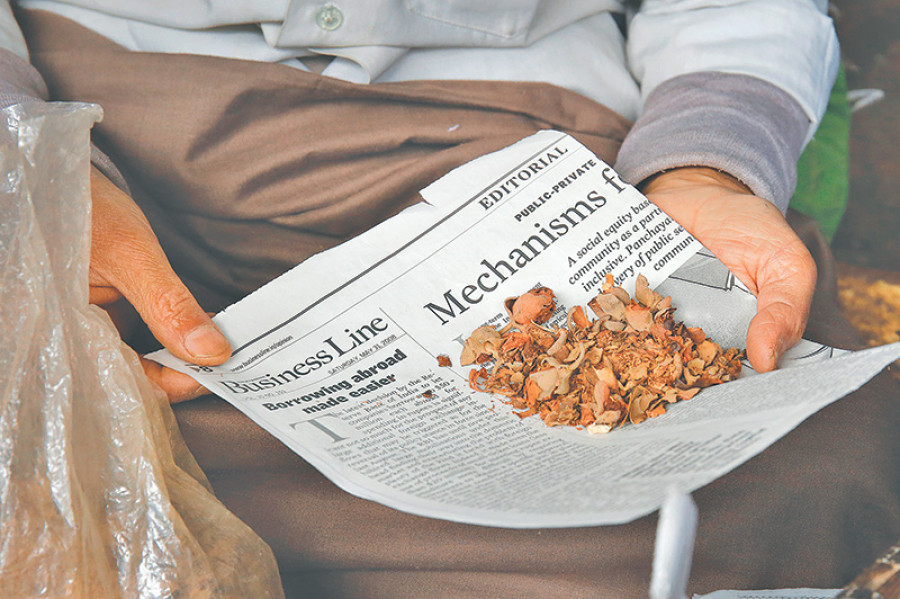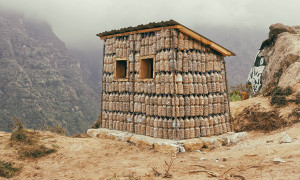Money
The test of time
Built by Kaji Abhiman Singh Basnyat in 1777 AD, the Paltan Ghar in Balkumari, Asan, is a house that distinctly stands out but also melts into its surroundings at the same time. Its imposing white facade and its vaulted windows are caked with thick layers of dust; and cable wires and election posters dangle hither-thither. Here, brass pots and butter lamps spill out into the street from their tiny, box stores and thousands of people walk by each day without noticing a traditional Ayurvedic store that dates back to the early sixteenth century.
Abijeet Pant
Built by Kaji Abhiman Singh Basnyat in 1777 AD, the Paltan Ghar in Balkumari, Asan, is a house that distinctly stands out but also melts into its surroundings at the same time. Its imposing white facade and its vaulted windows are caked with thick layers of dust; and cable wires and election posters dangle hither-thither. Here, brass pots and butter lamps spill out into the street from their tiny, box stores and thousands of people walk by each day without noticing a traditional Ayurvedic store that dates back to the early sixteenth century.
In truth, Tilinga Ausadhalaya is easy to miss. Barely three feet across and 10 feet deep, its proprietor, Basu Krishna Baidya, admits that at his establishment, three is crowd. Lined with glass cupboards and wooden chests that contain over three dozen different herbal concoctions and oils, Basu Krishna’s store can be eerily quiet one minute, then buzzing with activity another. All the while, a photo of Dhanvantari, the vedic god of Ayurveda and good health, presides over it all from the far wall.
By 1518 AD, Basu Krishna’s ancestors were La-Mula Baidyas (head physicians) to the royal Malla household in Patan. Then after Prithvi Narayan Shah sacked Kathmandu Valley, the La-Mula Baidyas were stripped off their titles, forcing them out of the palace and into the service of the public at large. “Eventually,” Basu Krishna says, “they opened up the Tilinga Ausadhalaya in 1778 AD and moved to this tiny store at the Paltan Ghar.”
Basu Krishna’s shop might be one of the oldest Ayurvedic shops in Asan, but around the corner towards Itumbahal and Kilagal, one can expect to find a dozen other shops such as Jadibuti Baidya Pasal (80 years), Madan Ayurvedic Store (90 years), and Baidhya Ausadhi Pasal (120 years), among others. And this congregation of traditional healers in one locale, Manjiv Shakya, a traditional Baidya, says, can be traced back to the Bhaskar Vihar, a monastery in Itum bahal.
According to Manjiv, Bhaskar Vihar is said to be at least 900 years old, perhaps even older. After migrating to Itumbahal from Sankhu, Manjiv’s ancestors helped build the Vihar as a public space that housed shops, Ayurvedic healers, a school, and also hosted visiting scholars from Tibet and beyond. And though, most of the other functions of the Vihar have long ceased, its vicinity remains a popular location for traditional herbal shops.
(Left) Basu Krishna Baidya in his 240 years old shop; Traditional motar and pestle
“All the other aspects of the Vihar’s early identity have vanished today,” Manjiv says, “But one reason why Ayurvedic healers did not is because health has always been an intrinsic need of the society. This is why these shops have stayed in the neighbourhood and continue to remain as busy as ever.”
In 1894 AD Manjiv’s great-grandfather opened his first shop at Kilagal. Then in subsequent years, as the joint family separated, the shop was divided into three—one of which is owned by Nem Kaji Shakya (Manjiv’s uncle) today.
On any given day, you can find Nem Kaji seated in his shop making one concoction or another. Jars, vessels, and Pyang (bamboo containers that regulate humidity) full of remedies surround him and the thick aroma of herbs and spices hangs heavy in the air. Throughout the day, patients trickle in, briefing Nem Kaji about their ailments.
Hari Khattri, 65, for instance, has come all the way from Maharajgunj looking for packets of Aswagandha for his chronic insomnia. Raju Joshi is here to buy some Bojho for his son’s unrelenting fits of cough, while Pushpa Dangol is looking for Trifala for her long-standing digestive ailments.
All their requests are met by Nem Kaji’s short inquiries about the history of the illnesses, much like a doctor would. Then, carefully measuring out portions on a rusty scale, he packs his homemade remedies in newspaper pouches, before briefing the customers about the dosage and consumption.
“Who would have thought that in this day and age people would still come seeking traditional herbal remedies,” Nem Kaji says, “But they do. Whether it is because they’re seeing side effects from Allopathic medication or because they’ve been using herbal remedies for a long time, and trust it, customers continue to flock to our shops. You can hardly say business has slowed over the past few decades, maybe just a bit.”
All the traditional herbal shops in the Kilagal neighbourhood, Nem Kaji says, have close ties with one another; and except for the differences in the physical space, the purpose of all these shops are nevertheless the same. Not only do Baidyas treat patients, but they also sell over 300 kinds of medicinal herbs such as Jatamasi (Spikenard), Chiraito (Swertia), Sarpagandha (Serpentine root), Harro (Black Myrobalan), Barro (Myrobalan) and Timur (Sichuan pepper), in addition to about 60 different medicines and essential oils prepared from these herbs.
“Most of these herbs treat common ailments—cough, cold, indigestion—and some can serve as supplements to medication being taken for diabetes, jaundice, gastritis and blood pressure,” Nem Kaji says, “Which I think strikes a good balance. We are not the first door people with serious ailments are knocking on, but if there is something supplemental that our millennia-old body of knowledge can do, we are here.”
(left) Nem Kaji Shakya at his store; Customers throng to a Baidya store in Kilagal. Post Photo: Anish Regmi
Around the corner, at Basu Krishna’s Paltan Ghar storefront too, most remedies come with a price tag of Rs 100-200. “The best thing about herbal concoctions is that they are cheap and don’t have any side effects,” he says, “But sometimes, we make more complex compounds. This is when things get interesting.”
For instance, Basu Krishna points out, Bhasma—which is made from iron, copper, silver and even gold and diamonds—can cost up to Rs 1000, depending on what it is made with. “Converting these metals into a medicine involves complex chemistry,” he says, “When done right, you could say it is pure alchemy.”
The first step for producing Bhasma, Basu Krishna says, is to weaken the solid form of metals, minerals, or stones. Once they are dipped in Gahut (cow urine) or Trifala (a drug made from Harro, Barro, and Amala) for several days, the metals weaken and become extremely malleable. Eventually, the bits and pieces are dipped in herbal extracts and heated continuously and then dried in the sun. The process is repeated a 100 times over, and producing portions of Bhasma may take six month to a year and are used to treat chronic ailments such as Arthritis, respiratory diseases, and immunity system disorders, among others.
“More the heating and drying process is carried out, the toxicity of the solid decreases and the medicinal property increases.” Basu Krishna says, “These drugs are highly effective, which is why our calculations of the proportions, and ratio for the prescriptions have to be accurate to every last figure. I have spent up to five years distilling and purifying different compounds and extracts; it is natural science meeting the highest form of art.”
But while herbal remedies remain as popular as ever, Baidyas like Manjiv admit that the future of the profession remains precariously balanced at the moment.
“My interest in herbs began early. I remember following my father to his shop when I was as young as 10 years old,” Manjiv shares, “You don’t become a Baidya overnight. I had to apprentice at the store for 10 years before I was allowed to begin mixing herbs on my own. As for my own kids, they hardly ever drop by my shop. And I have no intention of pushing them towards this line of work if they are not fully interested.”
Apart from the declining interest among the younger generation, Manjiv also cites the lack of quality raw materials as another major problem traditional Baidyas are facing today. Only a couple generations ago, he says, Baidyas would go on long journeys into the countryside to harvest medicinal plants. What they couldn’t gather themselves, they purchased from trusted traders from India. But now with the rapid commercialisation of the industry, particularly in India, herbs are more accessible than ever but aren’t as unadulterated as in the past.
“This has a two-fold effect,” Manjiv says, “Production costs have shot up while the effectiveness of the remedies has decreased. When that happens, the trust our customers put in us erodes slowly.”
But while Baidyas like Manjiv and Basu Krishna are determined to continue their age-old professions despite the odds, they are also acutely aware of detractors who label them as unscientific and even as quacks.
Down the road from Kilagal at the Naradevi Ayurvedic Hospital, Ayurvedic physician Dr Ram Chandra Pandey is of the opinion that there is a need to regulate the scope of the traditional Baidya stores.
“If you talk about legality, traditional healers do not have licenses—neither to treat people nor to produce medicine. They can only sell medicine according to prescriptions,” he says, “Despite this, they continue their practices. While there is no denying that herbal remedies can be beneficial, some compounds can also be toxic when not administered by experts. And it takes just one untoward incident to drag the name of the entire profession into the mud.”
But Narayan Prasad Dhakal, director general of the Department of Drug Administration, shares that monitoring traditional Ayurvedic shops lies beyond the scope of the department.
“Traditional shops function at a very small scale and they are usually based within a household,” he says, “As this is not commercialised or purposed for mass consumption, they have not been under our monitoring and supervision. Should the need arise in the future, we could possibly bring in mechanisms for supervision.”
Dr Pandey, however, believes that a balance can be struck. As an example he points to regulations that were introduced in China in 2016 that require all Traditional Chinese Medicine (TCM) practitioners to pass tests and obtain licenses. Even experienced traditional healers who have been practicing for decades are being licensed after tests and recommendations. “But in order to do that,” he says, “There needs to be adequate research on the herbal remedies and a set of standards to abide by.”
Manjiv, who is also the secretary of the Traditional Ayurvedic Medical Practitioners Association, remains open to the idea of licensing traditional shops but also reiterates that because the lineage and the practice of Kathmandu’s Baidyas evolved independently and uniquely, importing standards set elsewhere is not the answer.
“Yes, it is a profession but it is also a tradition that has been passed on for thousands of years. There are people who represent 25, 26, 27 generations of continual practice. And that in itself is worth saving and perpetuating,” he says, “Besides, were are not snake oil salesman promising miracles. We don’t have cures for cancers or broken bones. But if we didn’t add value to the society, we would have been driven out of business a long time ago.”




 18.12°C Kathmandu
18.12°C Kathmandu














